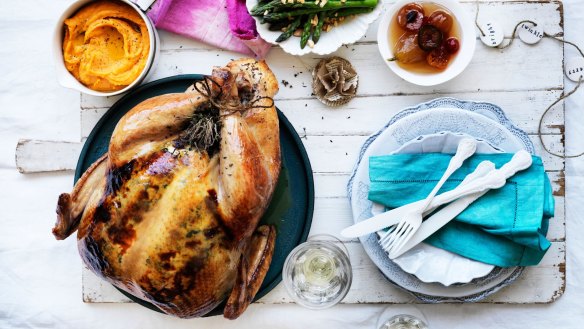What's the best way to avoid a dry turkey?

What's the best way to avoid a dry turkey? P. Lee
Buy one from the supermarket from one of the big poultry growers. They are pumped so full of water and diphosphates that they are almost guaranteed to stay moist. Some of the brands are so full of additives they are just 90 per cent turkey. The alternative is to brine your own turkey for a similar outcome with fewer chemicals. Simmer 2.5 litres of water with 350 grams of table salt, 100 grams of brown sugar, a tablespoon of peppercorns, four bay leaves, a lemon cut in half and a few teaspoons of your favourite spice seeds for 10 minutes. Add 2.5 litres of cold water. Allow to cool. Place a 3.5-kilogram turkey in a large container. Pour over the brine. Refrigerate for 24 to 48 hours before roasting. Drain and dry on a rack. Preheat the oven to 220C (200C fan-forced). Truss the legs. Rub oil and salt into the bird. Roast for 20 minutes then reduce the heat to 160C and cook for a further 2-2.5 hours or until the bird is cooked through. If the extremities brown too much cover with foil. Cover. Rest for 15 minutes. (As a general rule cook turkeys at 180C (160C fan-forced) for 40 minutes per kilogram for the first 4 kilograms, then 45 minutes per kilogram after that. Internal temperature should be a minimum of 65C). I cook the stuffing separately because it acts like a great wad of insulation, stopping heat moving through the bird. I shape the stuffing into a log, wrap in greased baking paper, then foil, and cook it with the bird in its final hour.
What's the difference between yams, sweet potatoes, kumara and South American oca? L. Sutherland
Yam is a word that is used to describe hundreds of different tubers we use for food. True yams come to us from sub-Saharan Africa. On the west coast, in countries such as Ghana, they are called nyami, which comes from the verb to eat. This became inhame in Portuguese and yam in English. Its genus name is Dioscorea and there are eight edible species that are native to Africa, China, south-east Asia, tropical South America and Australia. Our yam is the cheeky yam and eaten in the top end by traditional owners. In southern states we have daisy yam or murnong, also a native Australian food, which has a yellow flower and a white taproot with a radish-like texture and sweet flavour. In America they use the word yam to describe what we called sweet potatoes. Known to botanists as Ipomoea batatas, sweet potatoes are native to tropical parts of the Americas and grow as a vine that forms a tuberous root. It has a fine skin, orange flesh and is a good source of vitamin A. In New Zealand they are referred to as kumara. Across the Tasman they also grow a tuber most of the world call oca, a type of edible oxalis. It looks like a great, pink, swollen witchetty grub but is a fine-skinned tuber native to the Andes in South America. But to add to the confusion, Kiwis call it a yam.
Send your vexing culinary conundrums to brainfood@richardcornish.com.au or tweet or insta @foodcornish
- Read more: Neil Perry's roast turkey with stuffing
Restaurant reviews, news and the hottest openings served to your inbox.
Sign up- More:
- Restaurant news
